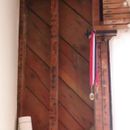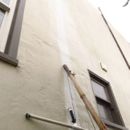Elastomeric paint for avoiding cracked stucco tear-off?
Has anyone had good experiences with an elastomeric paint, or a trowel coating like Stuc-O-Flex Elastomeric Acrylic, on older homes?
I have a 1938 home with a small remaining stucco leak. Little dribbles of water continue to wet the skip sheathing, despite attempts to caulk every external crack and the visible scupper drain.
The 1938 paper in this area is completely gone: it’s possible to touch the exterior stucco from the inside of the wall cavity.
There was a bigger leak in the same spot caused by the original 1938 downspout nails getting smaller over time, and wicking water in (they were angled down into the wall). It’s clear the damage accelerated substantially when cellulose was added to the wall, and when it all had to be pulled out, it was a moldy sopping wet mess.
Now it’s a small leak that can’t be found. What would you do? The stucco companies want about $12000 per wall section, and of course that generates thousands of pounds of landfill. Climate: non-freezing, San Francisco, zone 3C.
GBA Detail Library
A collection of one thousand construction details organized by climate and house part











Replies
Bryce,
It is impossible to make stucco 100% waterproof at the surface, despite the claims of surface coating companies. There must be a drainage plane behind the stucco and some ability for water to weep from the base of the system. Your stucco has lasted 80 years primarily by luck and good fortune, with the inherent durability of the solid lumber sheathing thrown in. As you have discovered, insulating the walls changes the moisture dynamics for the worse.
Unfortunately, chasing leaks like this is a losing battle. Even if you get the leak sealed right now, how will you know when it starts leaking again? And it WILL start leaking again.
Your stucco has had a long life, and it is now time to replace it.
This is particularly problematic house, as it's a foam roof and Mediterranean style parapet with no overhang. Tearing off stucco means hell to pay on the roof/parapet wall intersection.
I don't disagree on the general point. Even for patch jobs elsewhere on the same house I used rain screen for extra drying potential.
Virtually all nearby stucco houses of the era are the same construction: stucco to the prior ground level with no weep. Generally the houses have settled in, bringing the ground level up even higher on the stucco. It's an invitation to termites.